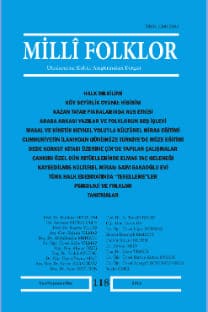AHMED YESEVİ’NİN YAŞNAMESİNDE “BİLGE KİŞİ” ARKETİPİ
The “Wise Man” Archetype in Ahmed Yasawi’s Yashnama
___
- Açıkgöz, Namık. Ahmed-i Yesevi’nin Yaşnamesi ve Halk Edebiyatındaki Örnekleriyle Mukayesesi. Türk Yurdu Dergisi, 1993, cilt 73, sayı 418, Eylül, s. 20-25.
- Aktulum, Kubilay. “Folklorik İmgelem Bir Toplumsal İmgeler Rezervuarı Olarak İmgelemin Epistemolojik Temellerine Giriş”, Millî Folklor, 2014, Yıl 26, Sayı 101, s. 277-290.
- Arıkan, Metin. “Kahramanın Dönüşümü”, Prof. Dr. Fikret Türkmen Armağanı, Kanyılmaz Matbaası, İzmir, 2005, s. 55-63.
- Çelebioğlu, Âmil. “Türk Edebiyatında Yaşnameler”, Eski Türk Edebiyatı Araştırmaları, MEB.Yay., İstanbul, 1998, s. 367-488.
- Davletşina, L.X. Funksionalnıy aspect oraza Mudreça v folklore tatarskoqo naroda. http:// www.tatfolk.ru/material_6.htm?random -19.08.2016.
- Duman, Mustafa. “Bozkurttan Hızır’a Türk Halk Anlatmalarında Kılavuz”. Millî Folklor, 2012, Yıl 24, Sayı 96, s. 190-201.
- Eliade, Mircea. Ebedi Dönüş Mitosu. (Çeviren: Ümit Altuğ), İmge Kitabevi, Ankara, 1994.
- Esirgen, Bilge. Türk Destanlarında Bilge Adam Tipi Üzerine Bir İnceleme. T.C Kocaeli Üniversitesi Sosyal Bilimler Enstitüsü. Basılmamış Yüksek Lisans Tezi, Kocaeli, 2007.
- Fikrətqızı, Elmira. Türk Xalqları Ədəbiyyatında Vücudnamələr.I cıld. Elm, Bakı, 2015.
- Gemalmaz, Efrasiyap. Ahmedi Yesevi’nin Hikmetlerinin Dili. http://incigemalmaz.tripod. com/yazilar/ahmediyesevi.pdf - 20.08.2016.
- Guerin, W. L.- Labor ve diğer. “Edebiyatta Mitolojik ve Arketipik Yaklaşım Tarzları”. (Çeviren: Sever Mustafa), Millî Folklor, (1997 Yaz), Ankara, c. 5, S. 34.
- Harmancı, Meriç. “Gurbet Türkülerine Arketipsel Bir Yaklaşım”. Turkish Studies International Periodical For The Languages, Literature and History of Turkish or Turkic Volume 8/4 Spring 2013,, p. 919-926, Ankara-Turkey.
- İçli, Ahmet. “Ruh’un Kendine Yolculuğu: Arketipsel Sembolizm Bağlaminda Sihhat ü Maraz Üzerinde Bir İnceleme”. Turkish Studies - International Periodical For The Languages, Literature and History of Turkish or Turkic Volume 8/13 Fall 2013, Ankara-Turkey p. 1017-1030.
- Jung, Carl Gustav. Analitik Psikoloji. (Çeviren: Ender Gürol). Payel Yayınevi, İstanbul, 2006.
- ___________. Dört Arketip, Metis Yayınları, İstanbul, 2005.
- Karagözlü, Volkan. “Arketipsel Sembolizm Bağ- lamında Mihr ü Vefâ Mesnevisinin İncelenmesi”, Turkish Studies - International Periodical For The Languages, Literature and History of Turkish or Turkic Volume, 7/1, Turkey, 2012.
- Kaya, Doğan. Yaşnameler. Akçağ Yayınları, Ankara, 2004.
- Koçak, Aynur - Mollaibrahimoğlu, Çiğdem. Yunus Emre’de Arketipsel İmgeler: “Risaletü’n Nushiyye” Örneği. X. Uluslararası Yunus Emre Sevgi Bilgi Şöleni Bildirileri (06-08 Mayıs 2010)., 2011, s. 635-646.
- Ocak, Ahmet Yaşar. Türk Süfiliğine Bakışlar. İletişim Yayınları, İstanbul, 1996.
- Ölçer Özünel, Evrim. ‘‘Halk muhayyilesi’’nde Bir Kahraman Olarak Ahmed Yesevi’nin Ola- ğanüstü İktidar Yolculuğu”. Millî Folklor, 2016, Yıl 28, Sayı 112, s. 15-29.
- __________. “Kendine Dönüşen Kahraman: Oğuz Kağan Destanı’nda İktidar Ve Kut”. Millî Folklor, 2014, Yıl 26, Sayı 104, s. 5-19.
- Quliyev, Hikmət, Müdrik Qoca Arxetipinin Semantik Strukturu və Paradiqmaları. Elm və Təhsil, Bakı, 2016.
- Şişman, Bekir. Günümüz Âşıklarında “Rüya ve Bâde Motifi”. Uluslararası Sosyal Araş- tırmalar Dergisi Cilt: 8 Sayı: 41 Aralık 2015:316-323.
- Tek, Zeynep. “Safiye Erol’un Dineyri Papazı Adlı Romanında Yüce Arketipinin Görünümü”. Bizim Külliye Dergisi, sayı: 66, 2015-2016: 72-77.
- Yesevi, Ahmed-i. Divân-ı Hikmet Seçmeler. (Hazırlayan: Kemal Eraslan), Kültür Bakanlığı yay., II. Baskı, Ankara, 1991.
- ISSN: 1300-3984
- Yayın Aralığı: 4
- Başlangıç: 1989
- Yayıncı: Geleneksel Yayıncılık Eğitim San. Tic. Ltd. Şti.
TÜRKİYE’DE SOSYAL MEDYANIN M/İZAHI: SOSYAL PAYLAŞIM AĞLARINDAKİ DENEYİMLERİN KARİKATÜRLERE YANSIMASI
ALMIS KAĞAN DESTANI’NIN ARKETİPSEL TAHLİLİ
BİYOGRAFİ: ETNOGRAFLAR İÇİN YÖNTEM VE ÖNERİLER
ETNOGRAFİ’DEN NETNOGRAFİ’YE SANAL ORTAMDA KURŞUN DÖKME: “SEN Bİ KURŞUN DÖKTÜR”
HEKİM FOLKLORUNDA STEREOTİPLERİN LAKAPLARI ŞEKİLLENDİRMESİ VE FIKRALARA YANSIMALARI1
ONUNCU YILINDA SOMUT OLMAYAN KÜLTÜREL MİRAS LİSTELERİ: GÖRÜNÜRLÜK, DEĞERLİLİK VE GÜVENİRLİK
KARAMANLI NEOKESARİA KÖYÜNDE DOĞUM GEÇİŞİNE AİT İNANÇLAR
KAMUSAL ALAN VE MODERNLEŞME SÜRECİNDE KIBRIS TÜRK KADIN DERNEĞİ: VARLIK KULÜBÜ
